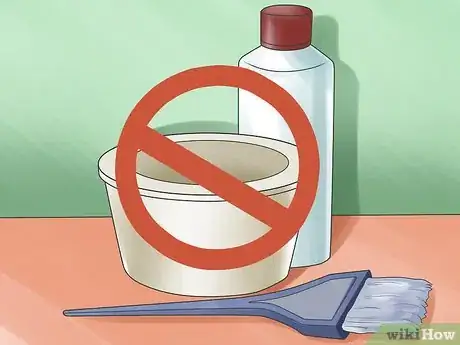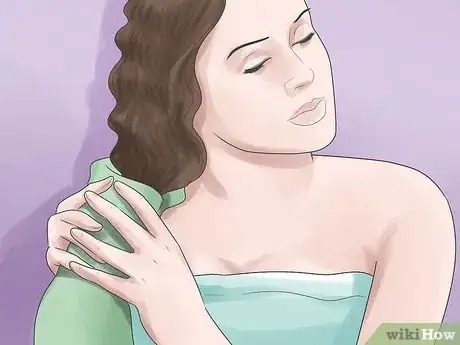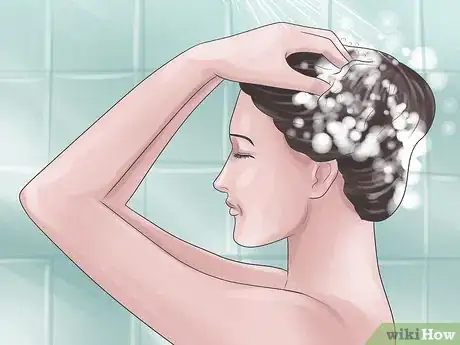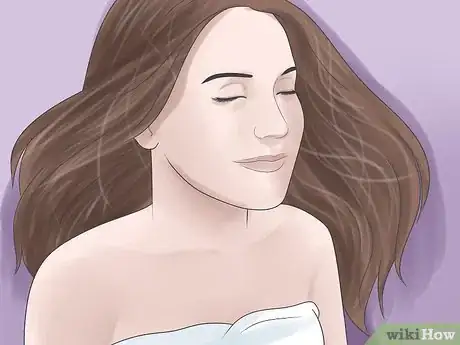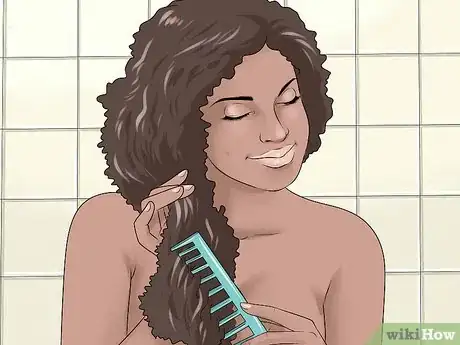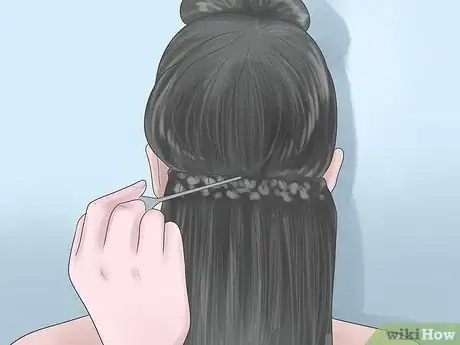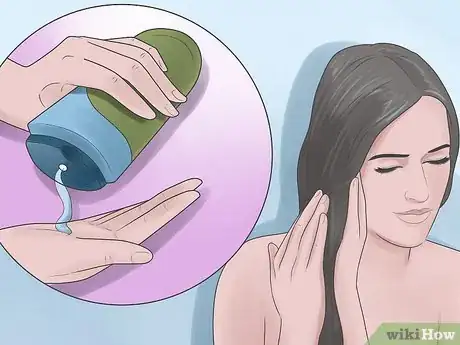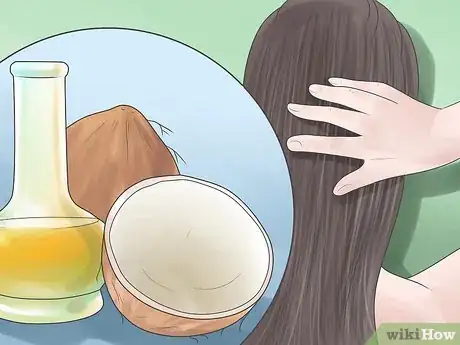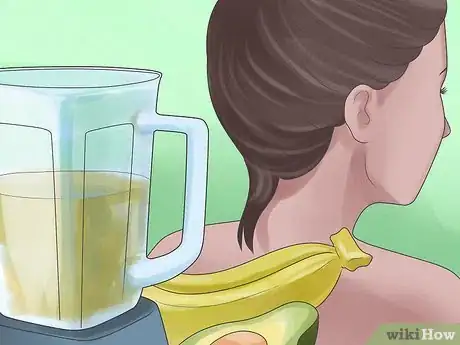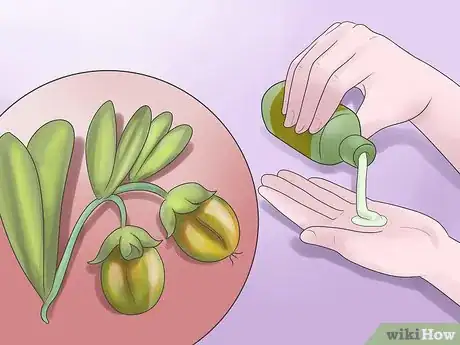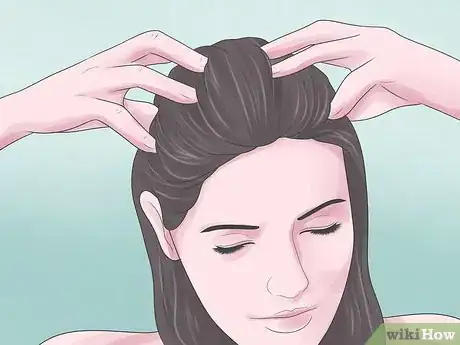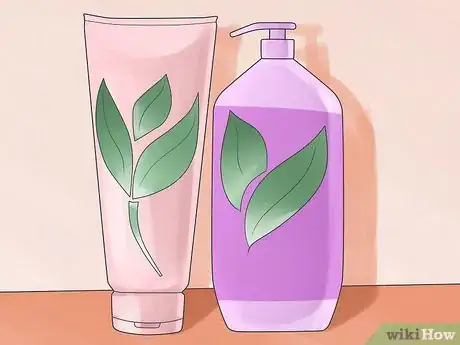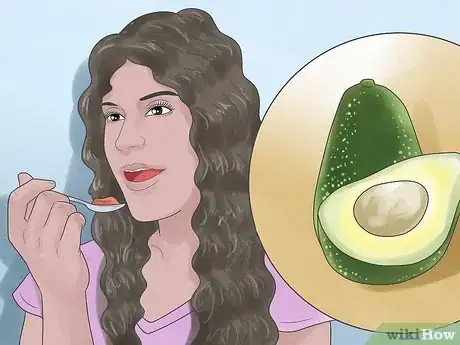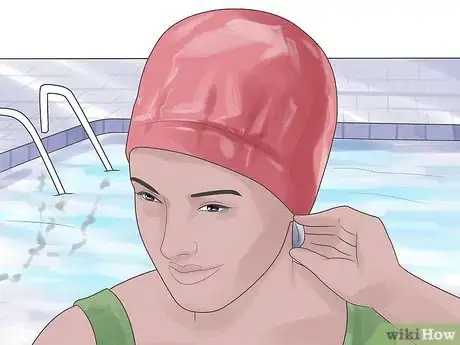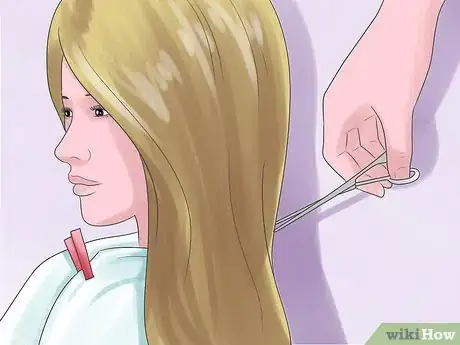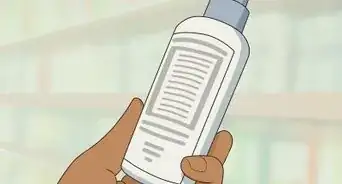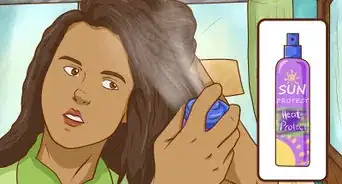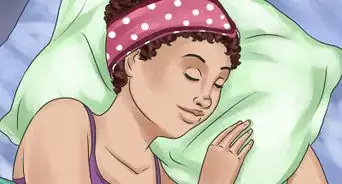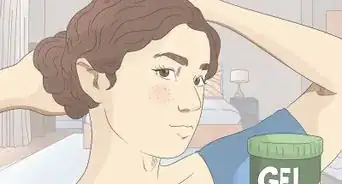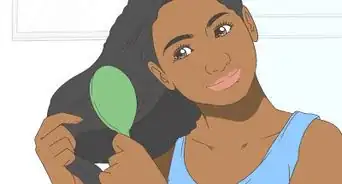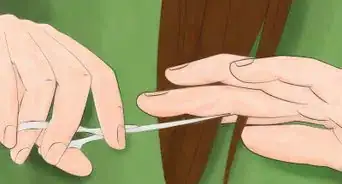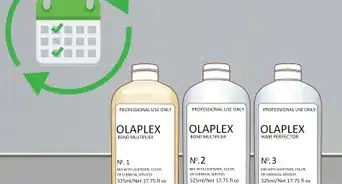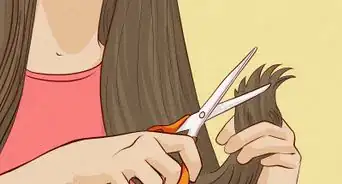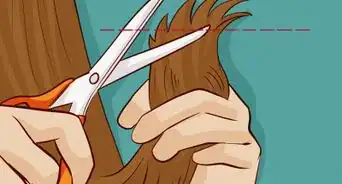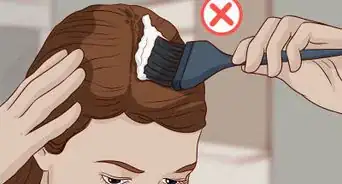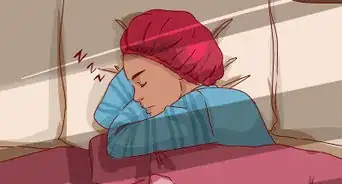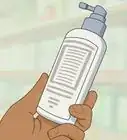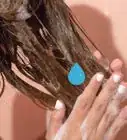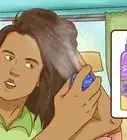This article was co-authored by Gina Almona. Gina Almona is the Owner of Blo It Out, a New York City-based hair salon. With over 20 years of beauty training experience, Gina's work has been featured in People Magazine, Time Out New York, and Queens Scene. She has been able to keep a fresh perspective in the industry by demonstrating and participating in trade shows and workshops like the International Beauty Show. She received her cosmetology training from the Long Island Beauty School, Astoria.
There are 15 references cited in this article, which can be found at the bottom of the page.
wikiHow marks an article as reader-approved once it receives enough positive feedback. This article received 11 testimonials and 89% of readers who voted found it helpful, earning it our reader-approved status.
This article has been viewed 1,193,657 times.
Does your hair feel brittle and stiff? Dyeing, bleaching, straightening or blowing out your hair a lot can damage it over time. These processes dry out your hair and leave it prone to breakage and split ends. Once your hair is damaged, the best way to restore it is to give it time to grow back in healthy and strong. Use deep conditioning treatments to help bring back its luster, and be healthy from the inside out to promote the growth of new healthy hair.
Steps
Helping Your Hair Recover
-
1Use harsh treatments in moderation. Many popular hair treatments strip the hair of its natural oils and damage the hair shaft. When you're ready to restore your hair, it'll be very difficult to do so unless you stop all treatments and let your hair return to its natural state. If you're used to relying on treatments to make your hair look the way you want it to, you may want to choose a few treatments that are the most important to you and stop using all of the rest. Here's what to avoid:
- Chemical hair dyes, either professional or from a box. If you love dyeing your hair, try a natural dye such as tea, which might actually help to restore your hair instead of damaging it.
- Bleaching your hair is never good for it. Stripping out the color in your hair does a lot of damage to the shaft, and can cause your hair to get brittle and break.[1]
- Chemical straightening or curling, like a Brazilian blowout, relaxers, or a permanent. The chemicals that force straight hair to be curly or curly hair to be straight and sleek do a lot of damage to your hair.
-
2Handle your hair gently when you wash and dry it. Hair is a fragile material that needs to be handled with care, especially when it's wet. Wet hair stretches and breaks easily, so it's important to be gentle when you're washing and drying your hair. Think of your hair as though it's a silk dress or a fine wool sweater. You wouldn't roughly scrub it, wring it out rub it dry with a towel, right? Just like special fabrics, your hair should be handled with care.[2]
- When you wash your hair, massage your scalp with your fingertips and gently pull the shampoo through your hair, rather than rubbing it vigorously. Do the same with conditioner.
- Let your hair drip dry for a few moments before gently squeezing out the excess water with a microfiber towel or T-shirt. Avoid using a bath towel to dry your hair as it may snag on the fibers, leading to breakage.
Advertisement -
3Shampoo no more than once or twice a week. The scalp produces a natural oil called sebum that protects the hair from drying out. When you wash your hair too often, you wash away this oil before it has the chance to travel down the length of your hair and provide protection. Washing your hair just a few times a week will help your hair stay shiny and healthy.[3]
- When you first stop washing your hair every day, your scalp will overproduce sebum, since it's used to your routine of washing it away every 24 hours. After a week or so things will balance out and your hair will no longer look greasy right away. If you have oily hair or skin, this process can take up to three or four months.
- If you're concerned about your roots looking greasy on the days in between washings, use dry shampoo to clean things up. You can buy a bottle of dry shampoo or making your own by simply mixing 1 tablespoon (14.8 ml) of cornstarch and 1/2 tablespoon (29.6 ml) of baking soda. Sprinkle it onto the greasy areas, let it sit for five minutes, then comb it out.[4]
-
4Let your hair air dry instead of using heat. This is a difficult rule to follow for people who are used to using hair dryers and other heat styling tools to create the perfect look every day. When your goal is to restore your hair to good health, using heat is like taking a step backward, every time. Start letting your hair air dry, and try to embrace your natural look to give your hair the chance to heal.
- Try putting in your styling products or combing your hair before you let it air dry. You can even shape it into the desired look before it dries to help with styling it.
- If you feel you really must use heat styling tools, use them on a low setting, and save it for special occasions. You can purchase a thermal protector, which often comes as a cream or spray, to apply to your hair before you use heat.
- Since your hair might take awhile to be completely restored, it may not look the way you want it to at first. You might be tempted to iron out those frizzy curls or bring some life to limp, dry locks. It's worth it to hold out until your hair is healthy; you'll see the texture improve immensely if you're patient.
-
5Brush your hair only when it's dry. If you brush your hair while it's wet, you can easily damage it. Work out tangles with a wide-tooth comb. Gently work it through your hair, starting near the tips and gradually working up toward the roots until you're able to move the comb through your hair without catching on a tangle. Once your hair is fully dry, you can use a boar-bristle brush to smooth it out.[5]
- Brushing with a plastic-bristled brush is very damaging to hair, especially when you try to brush through tangles. You end up pulling out hairs and breaking them off mid-shaft.
- If you have curly hair, avoid brushing it at all. Stick to using a wide-tooth comb.
-
6Avoid restrictive hairstyles. Certain styles pull on the hair and cause it to fray or break. Hair extensions and weaves are particularly bad for the hair. Whether they're sewn in or glued to your hair, they inevitable result in damage (and in worst-case scenarios, bald spots). When you're working to restore your hair to health, it's best to completely avoid styles that are hard on the hair.
Conditioning Your Hair
-
1Condition your hair each time you shampoo. Shampoo is designed to cleanse your hair, and conditioner to keep it hydrated, supple and shiny. When you condition your hair, place a dime or quarter-sized amount of conditioner in your palms. apply it at the ends of your hair, and use your fingers to work it up the length of your hair towards your roots. Focus on making sure the tips get special treatment, since they dry out much more quickly than your roots. Rinse your hair thoroughly when you're finished.
- Don't use more conditioner than you need to coat your hair lightly. Too much will weigh your hair down and make it look greasy. If your ends are extremely dry, you can add a little more to that area, however.
- For an extra glossy finish, rinse your hair using the coldest water you can stand. This will cause your hair shaft to lay flat and appear smoother and shinier than if you use hot water.[6]
-
2Do deep conditioning treatments once each week. Deep conditioning treatments are designed to penetrate your hair to keep it hydrated all week long. Apply a tablespoon or so of deep conditioner to your hair and comb it through. Start about one inch from the roots and work it down to the tips. Then pile your hair on top of your head and secure it with a clip, and cover it with a shower cap. Wait at least an hour before shampooing it out of your hair.[7]
- You can buy deep conditioning treatments from the store, or simply use a household item like coconut oil, almond oil or olive oil.
- Don't deep condition more than once a week, since doing it too often can actually damage your hair.
-
3Try a homemade hair mask. On days when your hair looks limp, dull, or frizzy, a hair mask can restore its nice texture and shine. Apply a hair mask after you wet your hair in the shower, and shampoo it out at the end of your shower. Here are common household items that do wonders for damaged hair:[8]
- For dull hair: use a tablespoon of honey or one egg white
- For frizzy hair: use one blended banana or avocado
- For dry hair: use a tablespoon of milk or yogurt
- For combination hair: use a combination of any of the above ingredients
-
4Use finishing oil or serum. After your hair is dry, hair oil or serum serves to keep it from frizzing and protect it from the elements. Look for an anti-frizz serum or combination hair oil, and use your fingers to comb just a few drops through your hair. If you don't want to buy a special serum, use a little of one of the following oils:
- Argan oil
- Moroccan oil
- Jojoba oil
- Egg oil
Growing Healthy Hair
-
1Massage your scalp. Massage promotes good circulation in the scalp, which helps your hair grown in healthy and strong. Make a habit of massaging your scalp every day. Place your fingers on your scalp and rub it using a gentle circular motion. This has the added benefit of helping to reduce stress and calm headaches.[9]
- Oil massages are even more helpful. Use coconut oil, almond oil, jojoba oil or olive oil to gently massage your head in the shower, then shampoo your hair when you're finished.[10]
- Some essential oils are said to help with hair growth. Try massaging with tea tree oil, egg oil, lavender or cedar wood oil.[11]
-
2Use natural hair products. Ingredients in your shampoo and conditioner may be making your hair damage worse instead of better. Switch to all-natural shampoos and conditioners that nourish your hair instead of harshly cleansing it and weighing it down with unnecessary chemicals. Here's what to look out for:
- Get a sulfate-free shampoo. Sulfates are harsh cleansers used in everything from dish soap to laundry detergent, and they're too hard on damaged hair. Look for shampoos that say "sulfate-free" and are made with natural cleansers.[12]
- Get a silicone-free conditioner. Silicons are added to conditioner because they make hair look shiny and smooth after the first few applications. However, over time they build up in your hair and cause it to look weighed-down and dull.[13]
-
3Be healthy from the inside out. Your daily habits can really impact the health of your hair. If you aren't eating a nutritious diet or getting enough water, your hair will definitely show it. Make a commitment to being healthy inside and out by doing the following:
- Eat plenty of hair-healthy foods that contain protein, omega-3 fatty acids, and iron. Try mixing starches and proteins for the best effect. Salmon, sardines, avocados, nuts, and flaxseeds are all excellent for promoting healthy hair growth.[14]
- Stay hydrated by drinking plenty of water. When you're dehydrated, your hair can end up getting dry and brittle.
- Avoid smoking cigarettes. Smoke damage can make hair look dull and dried out.
-
4Protect your hair from the elements. Just like environmental factors like the sun or extremely cold temperatures can affect your skin health, they can affect your hair health, too. Protect your hair with a hat or a bandana when you're outside for long periods of time.[15]
- Protect yourself from pool chemicals, too. Wear a swim cap instead of submerging your hair in chlorine.[16]
- Even air pollution can affect your hair. If you often walk or bike near traffic, protect your hair until you get to your destination.
- Wear your hair in protective styles like rolls and braids so that it becomes less tangled and is exposed less to the elements.
-
5Get regular trims. As new, healthy hair grows in, get regular trims to cut away the old, damaged hair. Getting rid of split ends will give you a fresh appearance, and over time you'll be able to see a big difference.
Expert Q&A
Did you know you can get expert answers for this article?
Unlock expert answers by supporting wikiHow
-
QuestionCan you grow damaged hair?
 Laura MartinLaura Martin is a Licensed Cosmetologist in Georgia. She has been a hair stylist since 2007 and a cosmetology teacher since 2013.
Laura MartinLaura Martin is a Licensed Cosmetologist in Georgia. She has been a hair stylist since 2007 and a cosmetology teacher since 2013.
Licensed Cosmetologist
-
QuestionHow can I repair dry, damaged hair?
 Laura MartinLaura Martin is a Licensed Cosmetologist in Georgia. She has been a hair stylist since 2007 and a cosmetology teacher since 2013.
Laura MartinLaura Martin is a Licensed Cosmetologist in Georgia. She has been a hair stylist since 2007 and a cosmetology teacher since 2013.
Licensed Cosmetologist You can't repair damaged hair, at least not permanently. However, using a weekly protein-based conditioner will add strength and using hydrating oils such as coconut and macadamia will help with shine and hydration. Just be consistent in your application; the damage may appear to lessen, but it won't be gone until you cut it off.
You can't repair damaged hair, at least not permanently. However, using a weekly protein-based conditioner will add strength and using hydrating oils such as coconut and macadamia will help with shine and hydration. Just be consistent in your application; the damage may appear to lessen, but it won't be gone until you cut it off. -
QuestionCan coconut oil help repair damaged hair?
 Laura MartinLaura Martin is a Licensed Cosmetologist in Georgia. She has been a hair stylist since 2007 and a cosmetology teacher since 2013.
Laura MartinLaura Martin is a Licensed Cosmetologist in Georgia. She has been a hair stylist since 2007 and a cosmetology teacher since 2013.
Licensed Cosmetologist
References
- ↑ https://www.livestrong.com/article/279654-is-bleaching-hair-harmful/
- ↑ https://www.livestrong.com/article/177148-how-to-properly-comb-wet-hair/
- ↑ https://www.nytimes.com/2016/10/24/fashion/how-often-should-you-really-wash-your-hair.html
- ↑ https://www.liveabout.com/how-to-make-dry-shampoo-with-baking-soda-and-corn-starch-1387830
- ↑ https://www.goodhousekeeping.com/beauty/hair/a33470/never-brush-wet-hair-myth/
- ↑ https://www.self.com/story/benefits-of-a-cold-hair-rinse
- ↑ https://www.anythingdayna.com/deep-conditioning-a-must-for-natural-hair/
- ↑ https://www.marieclaire.com/beauty/hair/a28285/homemade-hair-masks/
- ↑ https://www.livestrong.com/article/121028-massage-scalp-promote-hair-growth/
- ↑ https://www.webmd.com/beauty/natural-oils
- ↑ https://www.webmd.com/beauty/natural-oils
- ↑ https://www.livestrong.com/article/265025-why-are-sulfates-in-hair-products-bad/
- ↑ https://www.self.com/gallery/silicone-free-hair-products
- ↑ https://www.webmd.com/beauty/ss/slideshow-foods-healthy-hair
- ↑ https://www.everydayhealth.com/hs/quit-smoking/smoking-appearance-aging/
- ↑ https://www.health.com/beauty/chlorine
About This Article
To restore damaged hair, always handle it gently when it's wet and limit shampooing to once per week. Try to avoid heat styling tools such as blow dryers, curling irons, and straight irons, as well as chemical treatments like dyes, bleach, perms, and relaxers to prevent further damage. Deep condition your hair weekly and get regular trims to remove split ends as your new, healthy hair grows in! For more tips on conditioning and using hair masks, read on!
